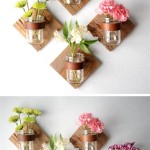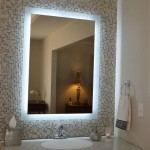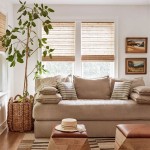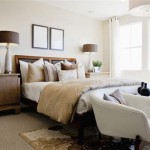How To Decorate a Blank Wall in Your Living Room
A blank wall in a living room presents a common decorating challenge. It can make a space feel incomplete, sterile, and lacking in personality. Effectively addressing this blank canvas can dramatically transform the room's ambiance, adding visual interest, depth, and a sense of curated style. The optimal approach depends on factors such as the room's size, existing décor, personal aesthetic preferences, and budget. Several strategies exist to convert a blank wall into a focal point or a harmonious element within the overall design.
Before beginning the decorating process, a period of thoughtful consideration is necessary. Evaluate the room's existing color palette, furniture arrangement, and overall style. Is the room modern, traditional, bohemian, or eclectic? Understanding the prevailing aesthetic will guide the selection of appropriate wall décor. Also, consider the room's function and traffic flow. A busy thoroughfare may not be the ideal location for delicate or protruding decorative elements. The size of the wall relative to the room's dimensions is another crucial factor. A large wall can accommodate a bolder, more impactful statement, while a smaller wall may benefit from a more restrained and understated approach.
The Artful Approach: Using Paintings and Prints
One of the most classic and versatile methods for decorating a blank wall is through the strategic placement of paintings, prints, or photographs. This approach allows for a high degree of personalization and can be tailored to fit any style preference. The selection of artwork should complement the room's existing color scheme and overall aesthetic. Consider the size, subject matter, and framing of the artwork to ensure it harmonizes with the space.
When hanging artwork, several arrangement options exist. A single, large statement piece can create a dramatic focal point, particularly on a large wall. Alternatively, a gallery wall, consisting of multiple smaller pieces arranged in a cohesive manner, can add visual interest and depth. The arrangement of a gallery wall can be symmetrical, asymmetrical, or a combination of both. Experiment with different layouts before committing to a final arrangement. Use painter's tape to mock up the arrangement on the wall to visualize the final result and avoid unnecessary nail holes. A useful guideline is to hang the artwork at eye level, ensuring that the center of the piece or arrangement is approximately 57-60 inches from the floor.
Consider the framing of the artwork. Frames can significantly impact the overall look and feel of the piece. A simple, minimalist frame can complement modern artwork, while a more ornate frame may be suitable for traditional pieces. The color and material of the frame should also be considered, ensuring they complement both the artwork and the surrounding décor. For a more contemporary look, consider floating artwork without a frame, allowing the artwork itself to take center stage.
Beyond traditional paintings and prints, explore alternative art forms such as textile art, tapestries, or sculptural wall hangings. These options can add texture and visual interest to the wall, creating a unique and personalized statement. Consider incorporating artwork with personal significance, such as family photographs, travel souvenirs, or pieces created by local artists. This will add a personal touch to the room and create a space that reflects your individual style and experiences.
Mirrors and Their Reflective Properties
Mirrors are not only functional but also serve as excellent decorative elements, particularly in living rooms. They can enhance the sense of space, increase natural light, and add a touch of elegance to a room. Strategically placed mirrors can visually expand a small living room, making it feel larger and more open. They also reflect natural light, brightening the space and creating a more welcoming ambiance.
The size and shape of the mirror should be carefully considered in relation to the wall and the surrounding furniture. A large, rectangular mirror can create a dramatic statement, while a collection of smaller, irregularly shaped mirrors can add a more whimsical and eclectic touch. Consider the style of the mirror frame. A sleek, modern frame can complement contemporary décor, while an ornate, vintage frame may be more suitable for a traditional setting. Frameless mirrors offer a minimalist aesthetic, blending seamlessly with any style.
The placement of the mirror is crucial to maximizing its benefits. Positioning a mirror opposite a window will reflect natural light into the room, brightening the space and creating a more airy feel. Placing a mirror behind a piece of furniture, such as a sofa or console table, can also add depth and visual interest. Avoid placing mirrors directly opposite doorways or in areas with high traffic, as this can create a sense of unease. When hanging multiple mirrors, ensure they are spaced evenly and hung at a consistent height. Consider creating a gallery wall of mirrors, combining different shapes and sizes to create a unique and eye-catching display.
In addition to traditional mirrors, explore alternative mirrored surfaces, such as mirrored tiles, accent walls, or furniture pieces with mirrored accents. These options can add a subtle touch of glamour and sophistication to the room. Consider using antique or distressed mirrors to add character and vintage charm. The reflective properties of mirrors can be further enhanced by incorporating lighting elements, such as sconces or spotlights, to highlight the mirror's surface and create a warm and inviting glow.
The Practical and Stylish: Shelving and Storage Solutions
A blank wall can also be transformed into a functional and stylish storage solution through the strategic placement of shelves or storage units. This approach is particularly useful in smaller living rooms where space is at a premium. Shelving and storage units can provide valuable storage space for books, decorative objects, and other household items, while also adding visual interest to the wall.
The type of shelving or storage unit should be carefully considered based on the room's style and storage needs. Floating shelves offer a minimalist and contemporary look, while traditional bookshelves provide ample storage space and a more classic aesthetic. Open shelving allows for the display of decorative objects, while closed cabinets provide concealed storage for items that you prefer to keep out of sight. Consider the material and finish of the shelving or storage unit, ensuring it complements the room's existing décor. Wood shelves can add warmth and texture to the room, while metal shelves offer a more industrial and modern feel.
The arrangement of items on the shelves is crucial to creating a visually appealing display. Avoid overcrowding the shelves and leave some negative space to allow the eye to rest. Mix and match different types of objects, such as books, plants, and decorative accessories. Arrange items in a balanced and cohesive manner, considering the size, shape, and color of each object. Group items together in clusters to create visual interest and avoid a cluttered look. Consider incorporating personal items, such as photographs, travel souvenirs, and family heirlooms, to add a personal touch to the display.
Beyond traditional shelving and storage units, explore alternative storage solutions, such as built-in bookshelves, wall-mounted cabinets, or ladder shelves. These options can provide unique and stylish storage solutions while also adding architectural interest to the wall. Consider incorporating lighting elements into the shelving or storage unit, such as LED strip lights or spotlights, to highlight the displayed items and create a warm and inviting glow. Integrate plants into the shelving display to add a touch of nature and create a more vibrant and inviting atmosphere.
In addition to these central approaches, various other techniques can be employed to effectively decorate a blank wall. A large tapestry or textile hanging can add texture and warmth to a room. A wall-mounted television can be integrated into the décor by creating a custom surround or concealing it with a sliding panel. Wallpaper, either on the entire wall or as an accent stripe, can add pattern and color. Consider using decals or stencils to create a custom design on the wall. Ultimately, the best approach is determined by individual preferences and the specific characteristics of the room.

10 Ways To Fill A Blank Wall How Decorate

How To Decorate A Large Blank Wall

Sharing My Easy Decorating Tips For Filling A Blank Wall Space Floating Shelves Living Room Home Decor Trends

7 Ways To Style A Big Blank Wall

How To Decorate A Big Blank Wall Sanctuary Home Decor

How To Decorate A Big Blank Wall Sanctuary Home Decor

How To Decorate Empty Walls For Home Interiors Beautiful Homes

8 Low Cost Ideas To Bring Life Blank Walls

How To Decorate A Large Wall Home Interior Design House Decor Inspiration

9 Ways To Decorate A Blank Wall
Related Posts







